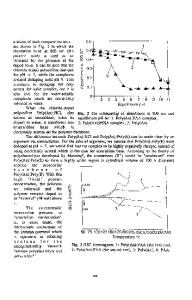Low Voltage Operation of Polymer Light-Emitting Device with Conducting Polymer Distributed Bragg Reflector
- PDF / 93,706 Bytes
- 6 Pages / 432 x 648 pts Page_size
- 103 Downloads / 300 Views
INTRODUCTION There have been many studies of organic light-emitting devices (OLEDs) with a microcavity structure [1, 2, 3]. These studies report modulated spectrum of emission from the microcavity OLEDs. Spontaneous emission from an active medium within a cavity is enhanced at the mode wavelength of a microcavity, and suppressed elsewhere. This controllability of spectrum by a microcavity can be used to improve the colour quality of electroluminescence in multicolour organic light-emitting devices. Most microcavity OLEDs studied have been of a similar structure, which is glass substrate / DBR (stack of dielectric layers) / ITO / light-emitting layer / cathode. In order to realize the full colour device with this configuration, the common DBR must have high reflectivity in the whole visible spectrum range. The width of the stop band is approximately given by λ∆n/n, where ∆n is the index difference between the layers that constitute the stack, λ is the center wavelength of the stop band, and n is the average refractive index. Typical mirrors such as SiO 2(n=1.5) / Si3N4(n=2.0) of a single period do not cover the whole visible. One can use a "chirping" DBR to widen the stop band, but this can result in multi-mode operation [4].
Some of us have recently reported a microcavity polymer LED whose DBR is semi-conductive and is placed between the ITO layer and the emissive layer [5]. This DBR is composed of polyphenylenevinylene (PPV) as the high-index layer and nanoparticle dispersed PPV as the low-index layer, having an index difference ∆n≈1 at 550nm wavelength. The ITO layer is placed outside the cavity, so that absorption by the ITO layer does not significantly increase loss in the cavity. This conductive DBR also enhances the flexibility in optical design of microcavities. In combination with an ink-jet deposition technique, one can for example fabricate DBR pixels of different design wavelength on an ITO-coated substrate at a low cost. In the present study, we have investigated polymer LEDs with a polymer DBR consisting of poly(9,9-dioctylfluorene-co-N-(4-butylphenyl)diphenylamine) (TFB)[6] and poly(3,4-ethylenedioxythiophene) (PEDOT)[7]doped with poly(styrenesulphonate) (PSS) to try another possible combination of polymers.
EXPERIMENT The structure of devices investigated in this study is shown in Fig.1 together with a refractive index profile and a schematic energy diagram. TFB shows high refractive indices (1.65-1.9) in the visible range due to an absorption edge at 420nm. The refractive index of PSS-doped PEDOT used in this study was found to be 1.54 at the wavelength of 560nm. When TFB and PEDOT are used as a high- and low- index layers, respectively, the index difference ∆n of 0.12-0.30 is expected in the visible range. The two polymers also have low absorption. TFB is transparent at wavelengths longer than 420nm. The PSS-doped PEDOT used for this LED has an extinction coefficient of 0.004 at a wavelength of 560nm. PEDOT has absorption beginning at around 1.5eV, which bleaches after doping [8], resulting in b
Data Loading...










